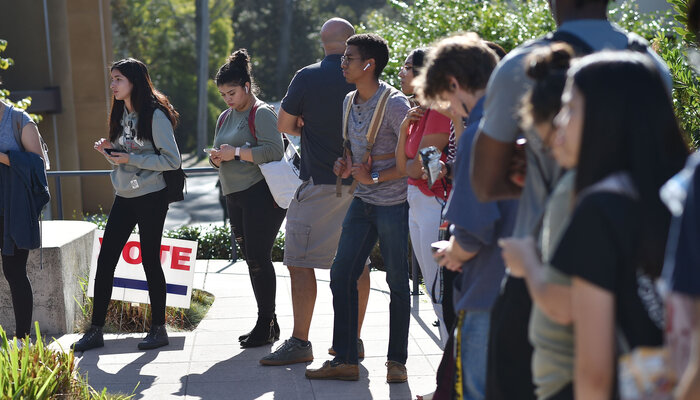Thursday marks the 50th anniversary of the ratification of the 26th Amendment, which gave the vote to Americans aged 18 to 21. It was the last seismic expansion to the franchise that we’ve seen in this country. However, in the decades since, new barriers to voting have been erected across the nation to suppress young voters. Urgent federal action, including the immediate passage of the For the People Act, is now needed to restore the promise of the 26th Amendment and guarantee youth suffrage.
The winding road to ratification
The story of the 26th Amendment stands out in America’s constitutional history. Not only did the amendment receive near unanimous bipartisan support across the country, but the interplay between grassroots organizing and legislative politics is one that can inform today’s fights for voting rights.
The path to the 26th Amendment began when Congress lowered the draft age to 18 during World War II, and the mantra of “Old enough to fight, old enough to vote” was popularized. West Virginia Democrat Jennings Randolph introduced the first proposal in 1943 based on the 15th and 19th Amendments, and he continued to sponsor it over the decades as a member of both the House and Senate. While the amendment made little headway in Congress, it was endorsed by leaders from both parties, including Presidents Eisenhower, Johnson, and Nixon.
By the late 1960s, amid the civil rights movement and protests against the Vietnam War, student activists at groups like Let Us Vote, the NAACP, and Common Cause organized to support their own enfranchisement. After decades of inaction, and looking to appease America’s youth, Congress passed a law lowering the voting age to 18 for all elections. But a 1970 Supreme Court ruling found that while Congress could lower the voting age in federal elections by statute, a constitutional amendment would be required to do so for state and local elections nationwide.
Sen. Randolph introduced his proposal once more, and the 26th Amendment swept through both chambers of Congress in March 1971. The amendment sprinted to ratification, reaching the needed 38 states in a record 100 days.
There is no single factor responsible for the success of the 26th Amendment, but take away any one element — organizers on the ground, bipartisan commitment to the vote, a steadfast champion in the Senate — and we likely would not have achieved this democratic milestone when we did. The story of youth suffrage, however, does not end in 1971.
Current efforts to suppress the youth vote
State lawmakers have long tried to make it harder for marginalized groups to vote, especially in the last decade. The most recent nationwide voter suppression campaign, spurred by false claims of fraud in the 2020 election, is raising new barriers to the ballot box that fall particularly hard on communities of color and young people.
These obstacles lead to lower youth turnout. For example, states have adopted restrictive voter ID laws that disproportionately burden young voters of color due in part to the financial, time, and transportation costs of obtaining valid voter IDs. States have also adopted early residency deadlines that often disqualify one of the most mobile voting blocs. New Hampshire and Wisconsin have fought to restrict student voting by excluding student IDs from being counted as valid voter ID and making it nearly impossible for out-of-state students to establish in-state residency for voter registration. And in Florida and New York, state lawmakers and election officials have fought to keep polling locations off college campuses.
Additionally, three of the states that disenfranchise formerly incarcerated people allow for the disenfranchisement of juveniles. This leaves the door open for young people to lose their voting rights before they ever gain them. Suppressive policies like these place compounded barriers onto young voters of color and disproportionately reduce the political power of their communities.
Limits on mail voting make it harder for young people to vote in states that condition eligibility for mail ballots on a voter’s age. This proved so egregious that a federal district court recognized Texas’ minimum mail voting age of 65 as a violation of the 26th Amendment.
This year, after seeing record youth turnout in 2018 and 2020, state lawmakers are continuing the push to restrict student voting. At least nine bills have been introduced to do so, with nearly half coming from New Hampshire. These bills would generally prohibit student IDs from qualifying as voter IDs and limit the ability for students to register to vote on campus. One law limiting the ability for student IDs to be used for voting has already been enacted in Montana.
The fight for youth suffrage continues
While many states are moving to suppress the youth vote, others are eliminating these barriers altogether. This year, at least 44 bills expanding student voting rights were introduced in state legislatures, and a handful were enacted into law. North Dakota will now allow public universities and colleges to issue a supplemental document to satisfy the state’s voter ID requirement. In Maryland, public universities and colleges are now required to host on-campus polling locations and institutionalize civic engagement. Virginia also expanded preregistration this year, providing young Virginians with a seamless transition into the electorate once they reach voting age.
But these piecemeal improvements are not enough. This year’s massive effort to rollback voting rights across the country underscores the need for federal action to protect all Americans’ right to vote, including young people. Last year, Rep. Chris Pappas (D-NH) introduced legislation that explicitly defines violations of the 26th Amendment and expands the protections provided under the amendment. President Biden has also called on Congress to pass the For the People Act and the John Lewis Voting Rights Advancement Act, which would provide further safeguards against the discrimination of young voters and people of color.
The For the People Act, a federal democracy reform bill that has already passed the House and is before the Senate, would transform how young people participate in our democracy. It includes key measures that can make our democracy more accessible to young Americans, including online voter registration, Election Day registration, preregistration for 16– and 17-year-olds, expanding state requirements for early voting locations to include college campuses, and requiring “campus vote coordinators” to provide election resources to students at higher education institutions.
Young Americans have been casting ballots for half a century now, but their ability to fully participate in our democracy has never been more precarious.
“The ballot is not just a piece of paper,” said Sen. Randolph upon passage of the 26th Amendment. “It is, in a sense, the exercise of freedom, the exercise of responsibility. I believe the young adults of our nation . . . have a very real mission to perform in bettering our country.”
While today’s political climate stands in stark contrast to that of 1971, there are several unmistakable similarities between the story of the amendment and the fight to pass the For the People Act. From the bill’s importance for civil rights, to the swell of organizing by the likes of Rev. William Barber and Stacy Abrams, to its broad bipartisan support among regular Americans, this renewed push to solidify our democracy rhymes with the history of our last great democracy reform.
In celebrating the 50th anniversary of the 26th Amendment, let us honor its legacy of expanding the franchise to young people by fighting for the Senate to pass the For the People Act and guaranteeing this freedom for the next generation of voters.





